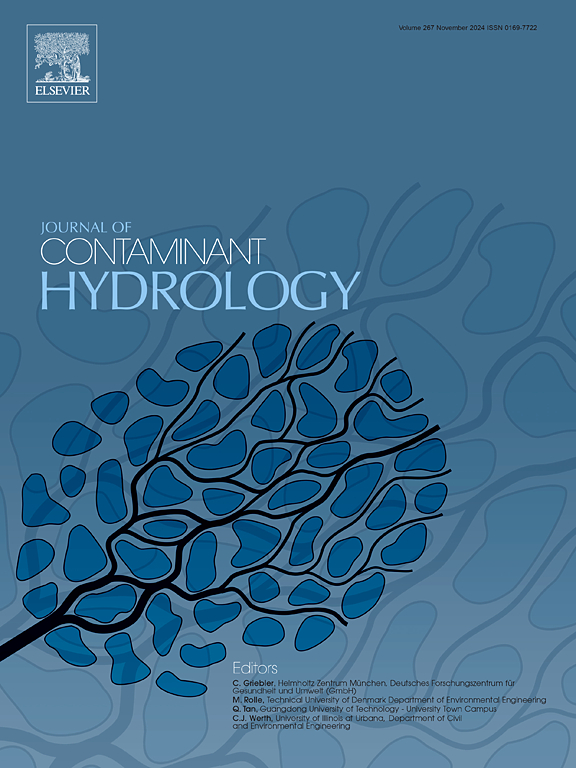风与生态退化作用下双层湿地流环境弥散特征
IF 3.5
3区 环境科学与生态学
Q2 ENVIRONMENTAL SCIENCES
引用次数: 0
摘要
流量和环境弥散对于控制生物多样性、管理生态系统和水资源至关重要。本文利用多尺度均质化技术建立了地表风作用下两层湿地流中污染物运移的扩散模型,并考虑了二级降解效应。本文的新颖之处在于描述了平均浓度在风和二度降解作用下的作用。正风向的增加导致湿地水流中输送能力的参与增大,导致深度平均平均流速的增大。垂直方向平均浓度和受污染物迁移影响区域的最大面积的解析解需要考虑水力分散和生态退化。结果表明,随着退化程度的增加,整个湿地的污染物垂直减少。同时,本文采用深度平均函数和无因次参数来显示风作用下污染物稳态输运影响区域的最大面积和持续时间。此外,针对典型的污染物成分Pb结构,给出了在一定标准水质水平下湿地中受影响的区域和最大面积的持续时间,并进行了分析。本文章由计算机程序翻译,如有差异,请以英文原文为准。
Characterization of environmental dispersion in two-layer wetland flow under the effect of wind and ecological degradation
Flow and environmental dispersion are crucial to control biodiversity and to manage ecosystem and water resources. Present study presents a dispersion model for a pollutant transport in two-layer wetland flow under the surface-wind along with second-degree degradation effect using multi-scale homogenization technique. The novelty of this paper is to characterize action of the mean concentration subject to wind and second-degree degradation effect. An increase in positive wind direction results in a larger involvement of conveyance capacity in wetland flows, leading to an enlargement of the depth-averaged mean velocity. An analytical solution for the mean concentration along the vertical direction and the maximal area of the region influenced by pollutant transport requires considering hydraulic dispersion and ecological degradation. As a results, it is seen that the pollutant reduces vertically throughout the wetland as the degradation increases. Also, this study uses a depth-averaged function and dimensionless parameters to show the maximal area and duration of the region impacted by the steady-state transport of pollutants under the influence of wind. Furthermore, for the typical structure of contaminant constituent Pb, the influenced duration of the region and maximal area are illustrated with a certain standard water quality level in the wetland and analysed.
求助全文
通过发布文献求助,成功后即可免费获取论文全文。
去求助
来源期刊

Journal of contaminant hydrology
环境科学-地球科学综合
CiteScore
6.80
自引率
2.80%
发文量
129
审稿时长
68 days
期刊介绍:
The Journal of Contaminant Hydrology is an international journal publishing scientific articles pertaining to the contamination of subsurface water resources. Emphasis is placed on investigations of the physical, chemical, and biological processes influencing the behavior and fate of organic and inorganic contaminants in the unsaturated (vadose) and saturated (groundwater) zones, as well as at groundwater-surface water interfaces. The ecological impacts of contaminants transported both from and to aquifers are of interest. Articles on contamination of surface water only, without a link to groundwater, are out of the scope. Broad latitude is allowed in identifying contaminants of interest, and include legacy and emerging pollutants, nutrients, nanoparticles, pathogenic microorganisms (e.g., bacteria, viruses, protozoa), microplastics, and various constituents associated with energy production (e.g., methane, carbon dioxide, hydrogen sulfide).
The journal''s scope embraces a wide range of topics including: experimental investigations of contaminant sorption, diffusion, transformation, volatilization and transport in the surface and subsurface; characterization of soil and aquifer properties only as they influence contaminant behavior; development and testing of mathematical models of contaminant behaviour; innovative techniques for restoration of contaminated sites; development of new tools or techniques for monitoring the extent of soil and groundwater contamination; transformation of contaminants in the hyporheic zone; effects of contaminants traversing the hyporheic zone on surface water and groundwater ecosystems; subsurface carbon sequestration and/or turnover; and migration of fluids associated with energy production into groundwater.
 求助内容:
求助内容: 应助结果提醒方式:
应助结果提醒方式:


